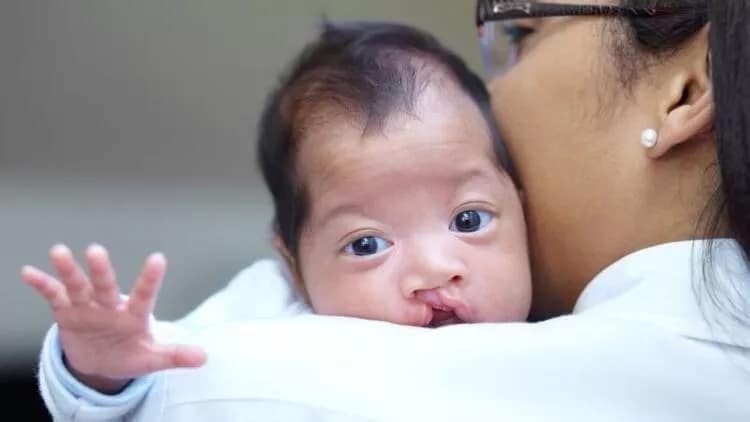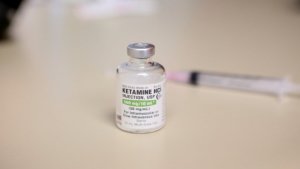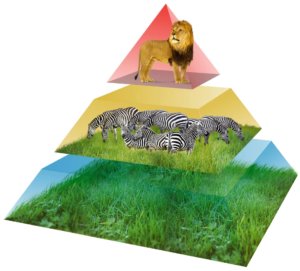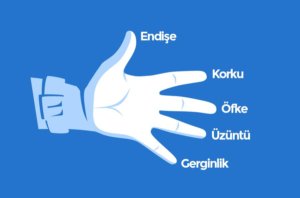Nager’s syndrome; It is a rare inherited disease that was first introduced to the medical literature by Nager and De Reynier in 1948.
It is a congenital condition that affects the bones and tissues of the face. It also appears to affect the arms and hands, and sometimes the legs and feet, while cheekbones, eye sockets, and chin may not develop properly in early pregnancy. This condition causes a characteristic appearance with downward sloping eyes and a small chin. Nager syndrome is similar to Treacher-Collins syndrome, with additional problems in the arms and hands and often associated with a cleft palate.
Nager syndrome is distinguished from other forms of acrofacial dysostosis by limb abnormalities, primarily on the thumb side of the hand and forearm, including underdevelopment or absence of the thumb and radius bones in the forearm and abnormal bone fusion in the forearms. Fingers and feet are usually normal. Intelligence is usually not affected. Nager syndrome is typically inherited in an autosomal dominant pattern and is caused by changes (mutations) in the SF3B4 gene.
Although an individual with Nager syndrome can pass the condition on to their children, many cases occur randomly as a new gene change in the family. This syndrome is typically inherited in an autosomal dominant pattern and is caused by changes in a gene called SF3B4.
What causes Nager syndrome?
Although doctors suspect that Nager syndrome may be a genetic condition caused by a change in a particular gene, the specific genes that cause the disease have yet to be identified.
The gene suspected to be involved in Nager syndrome alters the development of the first and second pharyngeal arches, i.e. the starting points in head and neck development, during early pregnancy. The pharyngeal arches are structures on either side of the head and neck that develop into facial and neck structures. In particular, the first and second pharyngeal arches form the nerves and muscles necessary for showing facial expressions and chewing, and structures in the outer ear and middle ear.
What are the symptoms of Nager syndrome?
Children with Nager syndrome have a characteristic appearance due to problems in the formation of the cheekbones, chin and eye sockets. If the chin is too small and/or underdeveloped, breathing difficulties may occur soon after birth. Jaw problems can also cause feeding difficulties.
In children with Nager’s syndrome, ears are usually absent or very small. If the internal structures of the ear are also underdeveloped, this can lead to hearing impairment.
The arms and hands are also affected in Nager syndrome. Most of the time, the elbow joint is stiff, so it can be difficult to bend the arm. The radius bone in the arm may be missing or underdeveloped, causing the hand to bend toward the body, i.e., deviate radially. This can affect all structures on the radial side of the upper extremity, including bones and soft tissues (muscles, tendons, joints, nerves, and blood vessels).
Children with Nager syndrome are also known to have problems with their hands. Most commonly, the thumbs of both hands are underdeveloped or absent, which can lead to problems with grip and fine movement. Other fingers may be abnormally curved, stiff, and sometimes syndactyly, or webbed. In some children, their legs and feet are similarly affected.
Rarely, it has been observed that other structures in the body are also affected.
Affected Populations
Although there is no evidence that Nager syndrome affects men or women more, it is known to affect men and women in equal numbers. The exact incidence and prevalence in the general population is unknown. however, most cases are misdiagnosed or underdiagnosed, making it difficult to determine the true frequency in the general population. More than 100 cases have been reported in the medical literature. Nager syndrome is the most common form of acrofacial dysostosis.
How is Nager syndrome diagnosed?
Since children with Nager syndrome have a characteristic appearance, we can say that there is no need for specific diagnostic tests. Experts say imaging scans such as x-rays, CT or MRI may be recommended to monitor bone growth before, during and after treatment, while hearing tests to diagnose hearing loss may be required, as well as imaging to examine the inner structures of the ear.
How is Nager syndrome treated?
Because Nager syndrome can affect various parts of the head and face, treatment is best given in a specialist center where a multidisciplinary team approach can be applied. The multidisciplinary team usually consists of craniofacial (skull and facial) surgeons, maxillofacial surgeons, ear, nose and throat (ENT) surgeons, hand surgeons, plastic surgeons, audiologists (hearing specialists), dentists and orthodontists, geneticists and speech and language therapists.
Initially, stabilizing a child’s breathing problems will require treatment. For some children, these are so severe that a tracheostomy, or artificial opening to the windpipe, may be needed to allow them to breathe. Some children may only need respiratory support at night.
If the thumb is present but weak, surgery may be done to stabilize any unstable joints and strengthen the thumb by taking a tendon or muscle from another part of the hand. If the thumb is absent or unstable, the index finger on that hand can be moved to the thumb position (pollicization). If any finger frets are causing a problem with function, it can be corrected during childhood with a series of surgeries. Later in childhood, the underdeveloped chin may require treatment. This is a long-term course of treatment, but it is also known to have good results for most children.
Ear reconstruction can also be done in later childhood, either by creating a new ear modeled on the other ear, or by creating the parents’ ears if both are absent. Ear reconstruction is a procedure that only improves the appearance of the ear, but does not affect its function. Hearing impaired children may need support in speech and language therapy with hearing aids or cochlear implants.
As bone continues to grow during childhood and adolescence, further surgery may be needed to reconstruct the face shape.
Related Disorders That May Be Similar to Nager Syndrome
The symptoms of the following disorders may be similar to those of Nager’s syndrome. Comparisons can be useful for differential diagnosis.
- Miller syndrome, also known as postaxial acrofacial dysostosis , is a rare genetic disorder characterized by craniofacial malformations presenting with arm, hand, and/or foot abnormalities, usually involving the postaxial (little finger or little toe) side. Craniofacial abnormalities include underdevelopment of the cheekbones (malar hypoplasia); an abnormally small lower jaw (micrognathia); incomplete closure of the roof of the mouth (cleft palate); small, protruding, “cup-shaped” ears; and/or absence of tissue in the lower eyelids (colobomas). Limb abnormalities may include underdevelopment, webcasting (syndactyly), and/or closure or absence of certain fingers and/or toes; and/or improper development and/or abnormal fusion of bones in the forearms (radioulnar synostosis) cause the forearms to appear unusually short. In some cases, additional physical abnormalities may occur. Intelligence is not affected. Miller syndrome is inherited as an autosomal recessive trait caused by mutations in genes.
- Treacher Collins syndrome (TCS) is a rare genetic disorder characterized by marked abnormalities in the head and facial region resulting from underdevelopment (hypoplasia) of certain facial structures, including the jaw, cheekbones, and nearby structures (zygomatic complex), and differs from Nager syndrome by: limbs are usually normal. Craniofacial abnormalities tend to involve the cheekbones, jaws, mouth, ears, and/or eyes. In addition to various facial abnormalities, affected individuals may have eye (ocular) abnormalities, including malformations of the outer ears and middle ear structures, and an abnormal downward tilt to the opening between the upper and lower eyelids (palpebral fissures). Affected individuals may develop hearing loss and respiratory (respiratory) difficulties. Moreover, brain and behavioral abnormalities such as microcephaly and psychomotor delay have also been sometimes reported as part of the condition. The specific physical characteristics and symptoms associated with TCS can vary greatly from person to person. Some people may have mild symptoms and go undiagnosed, while others may develop serious, life-threatening respiratory complications. TCS is known to result from a mutation.
- Rodriguez syndrome, also known as Rodriguez’s acrofacial dysostosis syndrome , is an extremely rare disorder. There is considerable overlap in both craniofacial and limb abnormalities in the Nager and Rodriguez syndromes. Some researchers believe that certain cases of Rodriguez syndrome may represent a more severe expression of Nager syndrome. In addition to the physical findings commonly found in Nager syndrome, individuals with Rodriguez syndrome may also have fibula, outer and narrower long bone of the leg (fibular hypoplasia), eleven ribs, shoulder and pelvic girdle underdevelopment, and heart underdevelopment. , central nervous system and urogenital abnormalities. Babies with Rodriguez syndrome are often stillborn or die immediately in the neonatal period due to serious airway problems.
- Various rare disorders include Weyers acrofacial dysostosis as a manifestation, Catania acrofacial dysostosis, and Palagonia acrofacial dysostosis. Other disorders that may have symptoms or physical findings that overlap with Nager syndrome include ophthalmo-acromelic syndrome, Pallister-Hall syndrome, mandibulofacial dysostosis type Guion-Almeida, Burn-McKeown syndrome, and oculo-auriculo-vertebral syndrome.
9 Ways to Protect Your Psychological Health
What Are the Symptoms of Pregnancy in 7 Days? How is Early Pregnancy Diagnosed?















